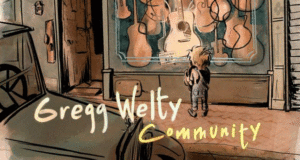Gregg Welty’s initial exposure to bluegrass music is like so many other musicians growing up in musical families. “I remember listening to my dad (the 1993 Winfield national bluegrass banjo champion) play music throughout childhood,” Gregg told me recently. “I really hated the Banjo for the majority of my childhood. When I was in middle school/early high school, I decided I wanted to learn electric guitar. Of course, my dad was the only guitar player I knew. So he taught me the couple of bluegrass guitar licks he knew (on an electric guitar by the way). It was learning those bluegrass licks and listening to bluegrass music while trying to play electric where I really began to appreciate bluegrass. I started playing banjo when he finally bought me a one for my birthday,” he recalled.
 Sticking With It
Sticking With It
Greg went on to college, continuing to appreciate and play bluegrass music. He played full-time for The Allegheny Drifters for a couple years. He also played with Gold Heart, the Haybalers, and a jam-band called Big Leg Emma. He’s done fill-in work for various bands as well, including a recent stint with Blue Mafia in 2017.
Gregg casually suggests that he has a day job too. No small venture, he earns his keep as med student/soon-to-be doctor. “I’m applying for residency training right now,” he commented. Nonetheless, his passion for his music runs deep. “I think that is why I spend a lot of my music time either playing in contests, recording (whether that means studio work for other people or writing/recording my own projects) and doing fill in work for various bands.”
To date, Gregg has won 15 state bluegrass banjo championships, “Which I think is the national record for most state contests. But I still can’t seem to win Winfield though,” he exclaimed. “But it’s next weekend, so we will see.”
So what does a medical doctor with 15 state banjo bluegrass championships do next? How about the largest collaborative effort for a bluegrass album, ever? He calls it Community, and it’s his latest CD.
The Big Idea
“I released my first record. Memoir, in August 2015. That was supposed to be a one off sort-of-thing. Just to see if I could do it. However, it was surprisingly super successful. I had a couple songs chart on the Bluegrass Today singles chart and the record was named by roots music report as one of the top bluegrass albums of the year. It was when I was actually doing a bunch of radio interviews for that project that sparked the idea for Community.”
“That first project had about eight guest artists on it. But the whole thing was done with a click track and done separately. Bass was recorded first with just the charts and a click, then mandolin, then guitar, etc. On interviews, people would ask, ‘how did you make this sound like it was live, when there are clearly a bunch of different studios?’ So I got the idea, how many artists could I get on one project? It’d be like a bluegrass family reunion! I think it became even more than that though. The first record was all about me. It was my record and about my musical journey, etc., etc. In the process of releasing that record, I realized that I am where I am because of the bluegrass community. The people who helped me get to where I am today, and it is really about everyone else – the Community!”
So Many Involved
“I mostly just asked,” when I asked him how he got so many artists involved with the project. “I had a couple people reach out to me and ask if they could be a part of it once they heard I was doing it, but for the most part I simply reached out to people. When I set out on this journey three years ago, I made a pact to not offend anyone, to only make friends in this process, to do it right. So I paid people what they asked, I let people take as much time as they needed, let them record where/when they wanted. I humbly reached out to people and said, ‘Hey, I love what you do. I’m working on this. Would you be a part of it? How much will it cost, and I’ll paypal you.”
Gregg was very careful to make sure nothing was lost in the quality of the final product though. “I didn’t want it to sound like it was done in 30 different studios. So, the rhythm tracks were all done live. Every song has the same rhythm guitar, bass, mandolin chops. No click track. Just live. And then I went back in with different vocalists and instrumentalists to sing all the songs, harmonies, breaks, etc. It was a gigantic project. I waited eight months for a single mandolin solo, but it is awesome. It was a waiting game. And truthfully, it worked out because it also stretched out the cost. I’d say, ‘Okay I have X dollars this month, I’m going to try and finish the baritone harmonies on these three songs.”
What Have You Learned
“I’ve learned so much it is honestly hard to put into words. I think first and foremost, if I didn’t love the bluegrass music community and those who are a part of it before, I sure do now! I still can’t believe the kindness, professionalism, and welcome I was shown by everybody that was a part of this record. It was so humbling. It really feels like you’re part of something bigger than yourself.”
 Americana Music Magazine – Bluegrass, Roots, Folk, Blues, and Old-Time
Americana Music Magazine – Bluegrass, Roots, Folk, Blues, and Old-Time